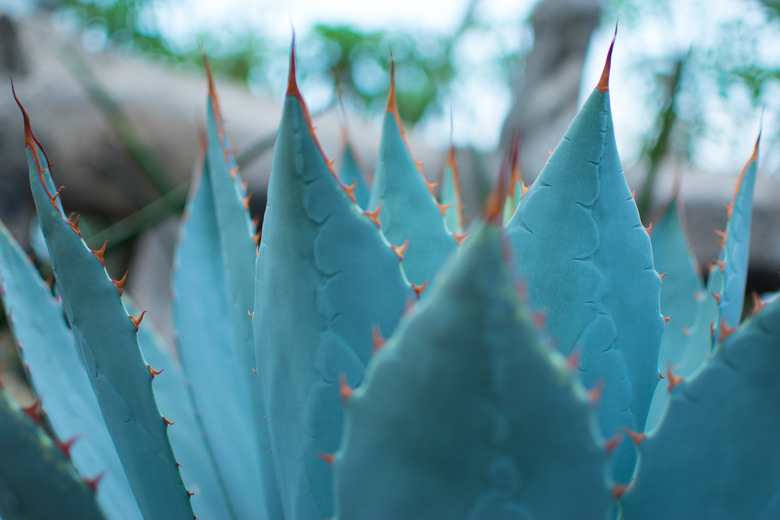How To Care For A Blue Agave Plant
You may not realize it when you're knocking back a margarita at the bar, but the tequila in that cocktail probably started partly as a humble plant. A hardy succulent called the blue agave helped to provide the nectar that gives tequila its natural sweetness. But along with being a crucial component of making liquors, the blue agave is a great houseplant. Thanks to its hardiness and lovely appearance, it's a great succulent for everyone from beginning gardeners to green thumbs.
Blue Agave Plant Uses
Blue agave plants are known in part for their striking appearance. When small, they have a green rosette shape but can quickly grow into large, bush-shaped plants with green spiky leaves jutting out of it. Sometimes, they reach more than five feet long and high. They're great natural additions to any home, whether you keep them as small plants for a sunny windowsill or let them grow wild to give your backyard a charming desert feel.
- You may not realize it when you're knocking back a margarita at the bar, but the tequila in that cocktail probably started partly as a humble plant.
- Thanks to its hardiness and lovely appearance, it's a great succulent for everyone from beginning gardeners to green thumbs.
Different types of agave plants, which dot landscapes across Mexico and in the American Southwest, aren't just great for landscaping. Thanks to strong leaves and a natural sweetness, they've been used to make a wide variety of products, including liquor, rope, netting and sturdy sandals. In addition, their flowers and stalks can be cooked and eaten.
Blue Agave in Tequila
The blue agave, or the agave tequilana, is, as its name implies, the plant most associated with the making of tequila. Also sometimes referred to as a blue agave cactus or tequila cactus, the plant gives its heart to make the popular liquor. The purest tequilas come from the blue Weber, a specific type of the blue agave plant.
Harvesters remove the heart of the blue agave plant at least seven years into its life. That heart is then heated and pressed to produce aguamiel, which is the name of the sap that the blue agave heart releases. Aguamiel is believed to have healing properties and is sometimes used in traditional medicines. But in tequila production, it's fermented and distilled, helping to turn it into different types of liquors including tequila, mezcal and pulque.
- Different types of agave plants, which dot landscapes across Mexico and in the American Southwest, aren't just great for landscaping.
- Thanks to strong leaves and a natural sweetness, they've been used to make a wide variety of products, including liquor, rope, netting and sturdy sandals.
Agave Plant Care
As more people become interested in brewing their own spirits, the blue agave has grown in popularity among those who want to make agave plant tequila. Others just want to add the succulent to their home or garden. No matter the reason, a blue agave plant is relatively easy to take care of with the right light and soil.
The blue agave plant grows best in areas like the American Southwest and Mexico. They like full sunlight, although some shade is okay, too, and soil that's sandy, rocky and free-draining. If you're growing a blue agave plant outdoors in that climate, you're in luck. All you need to do is plant it and give it water every few weeks, especially if it's been dryer than usual.
- As more people become interested in brewing their own spirits, the blue agave has grown in popularity among those who want to make agave plant tequila.
- All you need to do is plant it and give it water every few weeks, especially if it's been dryer than usual.
If you're growing a blue agave as an indoor houseplant, especially in an area that doesn't get much sun, the plant will require a little more work. Still, this is a hardy succulent that doesn't require nearly as much care as fussier houseplants, so it's great for anyone who hasn't quite honed their green thumb.
Pot your agave plant in a soil mix that's rocky and well-draining. You don't have to fret too much about pot size. While some plants need room for roots to grow long, blue agaves are succulents that take a while to outgrow their home. You likely can wait two to three years between repottings.
Make sure the agave gets plenty of sunlight each day. Many people love putting them on windowsills or screened in porches to help them soak up all the sun that they crave. The plant wants more sun than water. Exactly how much water your blue agave takes will depend on its size, location and the climate, but you can typically water it anywhere from every week to every month. When you find the soil beneath the plant completely dry, give it about an inch or two of water and make sure it drains well.
- If you're growing a blue agave as an indoor houseplant, especially in an area that doesn't get much sun, the plant will require a little more work.
- Still, this is a hardy succulent that doesn't require nearly as much care as fussier houseplants, so it's great for anyone who hasn't quite honed their green thumb.
With the right sunlight and a little love, the blue agave plant can be a fixture in your home for years to come.
